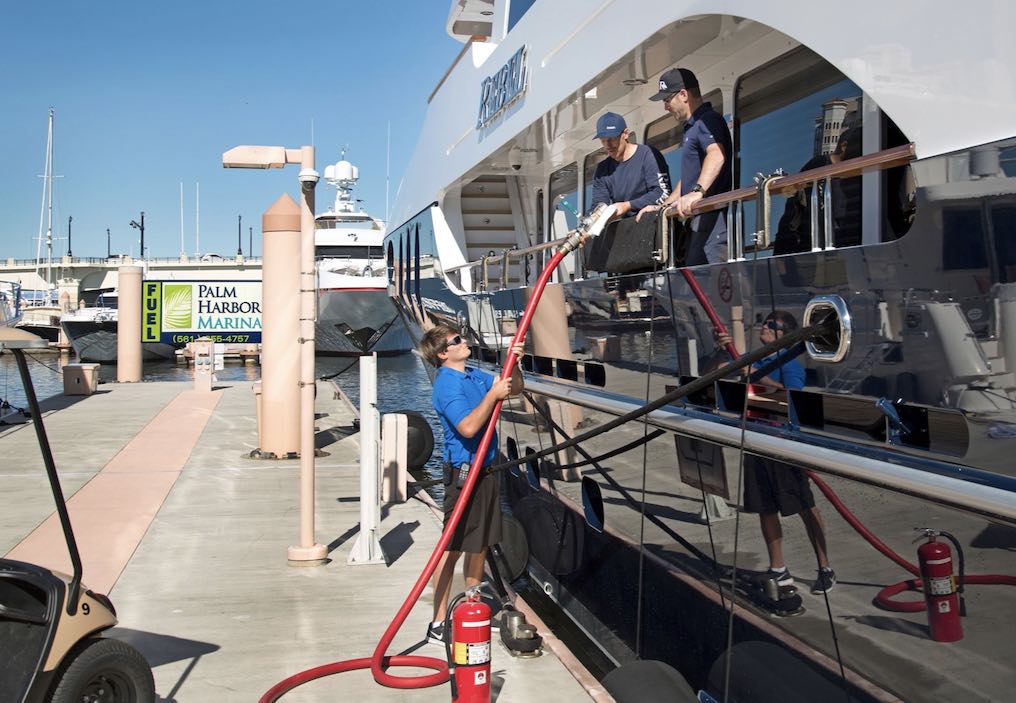Boat Safety Checklist

Enjoy a comfortable yachting experience while remaining safe and prepared! At Palm Harbor Marina, the premier marina in Palm Beach, Florida for yachting, we recommend taking every trip seriously and always implementing basic precautions before yachting for the day.
Boating Preparation and Safety Checklist:
Here at Palm Harbor Marina, we care about the customer satisfaction on land as much as we do on water. Part of your trip visiting Palm Harbor Marina includes your experience and enjoyment boating with your friends and family. The beautiful waters of Palm Beach, Florida are unforgettable, and the sunny weather matches the scenery. If you are planning to take a trip to the luxurious Palm Harbor Marina, we also encourage our guests to familiarize themselves with our Boating Preparation and Safety Checklist. In order to ensure the enjoyment, safety, and return of everyone on board the yacht, there are various preparations, procedures, and equipment required. Below we have created a highly recommended boating preparation and safety checklist:
- Is your boat in safe conditions to use out on the water?
- Are the oil, fuel, and fluid levels correct?
- Are all features of your boat fully functioning including lights and engine?
- Does your boat include all safety and equipment requirements?
- Are your guests safe and do they know what to do in case of an emergency?
- Do you and/or others know how to navigate and interact with other boaters so everyone is feeling safe?
- Is all electrically powered equipment fully working and charged? Batteries all charged?
Equipment/Tools:
- Buoyant Heaving Line: At least 15m long, for water rescues. Also consider at least one throwable floatation device such as a ring or pillow buoy.
- Manual propelling device or anchor with 15m rope: In case of engine failure.
- Visual signaling devices: Approved flares or waterproof flashlights with spare batteries.
- Sound signaling devices: Portable and fixed horns and whistles to attract attention and use in low visibility. Larger vessels also require a fixed bell.
- Fire extinguisher: This can be helpful in case of emergency. (notate photo above!)
- Bailer or hand pump: In case of water breaches or leaks.
- Add an emergency kit: Although not legally required, these additional items will be invaluable in an emergency. Always have an emergency kit on board.
- First Aid Kit: Have an easy-to-find first aid kit filled with the proper health and safety tools needed for a boating trip.
- Documentation: This includes boat registration and local water charts.
- Communication tools: This entails VHF Radio, marine UHF Radio, and cell phone (know which radio channels to use for local emergency assistance and ensure someone else on board knows how to use it).
- Navigation tools: Including charts, radar, GPS.
- Spare batteries: In case any battery-operated equipment needs replacing.
- Extra water and snacks: To help prevent dehydration and health concern problems.
- Essential weather kit: Sunscreen, sunglasses, hat, waterproof clothes.
- Dry change of clothes: To help keep dry and warm during an emergency.
- Knife: In case any supplies or equipment need to cut to prevent a worse situation.
When owning a boat and preparing to embark for the day, there are key steps to take when taking on the responsibility of being a boat captain and keeping everyone on board safe.
Captian's Responsibility:
- Become Knowledgeable: The first step to becoming a safe boater is being knowledgeable on your boat, equipment, location, and safety.
- Equipment Preparation: By law, there are required equipment when boating. Always triple check your gear and make sure you are following all legal boating requirements. It is always recommended to carry additional health and safety equipment on board in case of an emergency.
- Flotation Devices / Lifejackets: You must have at least one PFD per person on board. Ensure the flotation devices are easy to reach in case of an emergency.
- Pre-departure boat safety check: Before taking the boat out, go through your boat preparation and safety checklist to ensure a safe and comfortable ride.
- Educate your crew: Before you set off, make sure your guests know where the PFDs are and how to use them, how to use the radio and other signaling devices, and what to do in the case of an emergency if you are incapacitated.
- Weather Preparation: Properly prepare yourself and your crew for the weather throughout the day and ensure it is safe to be out on the water at that time.
- Additional Precautions: Never take the boat out without having someone on land knowing your schedule and plan. If things were to turn into an emergency and you had no way to communicate for help, it is recommended to inform someone close and nearby on your trip and return expectation for any duration out on the water.
- Not Driving Impaired: The rules are the same as driving inland; don’t drink and drive. You’ll be putting yourself and the life of others in danger when choosing to drive impaired.
Once you have familiarized yourself with the proper information and safety expectation, you can now ensure that you, your guests, and boat are fully equipped with the proper knowledge and equipment for a trip out on the water. Be sure to contact the staff at Palm Harbor Marina for any additional questions or to help plan your next visit at our luxurious location in Palm Beach, Florida.

 Local 561‑655‑4757
Local 561‑655‑4757